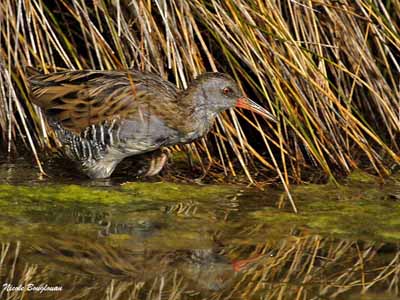
Water Rail
Rallus aquaticus
Gruiforme Order – Rallidae Family
BIOMETRICS:
Length : 25-28 cm
Wingspan : 38-45 cm
Weight : M : 88-190 g – F : 74-138 g
LONGEVITY: Up to 6 years
DESCRIPTION:
Water Rail is a secretive bird, more often heard than seen.
Fr: Râle d’eau
Esp: Rascón Europeo
Photographers :
Aurélien Audevard
His website :
OUESSANT DIGISCOPING
Steve Garvie
His website :
RAINBIRDER Photo galleries
Other pictures and text by Nicole Bouglouan
Sources:
HANDBOOK OF THE BIRDS OF THE WORLD Volume 3 by Josep del Hoyo-Andrew Elliott-Jordi Sargatal - Lynx Edicions - ISBN : 8487334202
THE HANDBOOK OF BIRD IDENTIFICATION FOR EUROPE AND THE WESTERN PALEARCTIC by Mark Beaman, Steve Madge - C.Helm - ISBN: 0713639601
THE COMPLETE BOOK OF BRITISH BIRDS – Written by “Royal Society for the Protection of Birds” experts - Préface de Magnus Magnusson - Michael Cady- Rob Hume Editors - ISBN: 0749509112

Adult have dark chestnut upperparts with black patches. This pattern is given by the broad chestnut edges on head and mantel, but we can also see fine white markings on primary coverts and flight feathers.
Underparts are slaty-grey with conspicuous barring on flanks. Undertail coverts are buff spotted black, but it appears white when we see only the profile.

Head shows slaty-grey face and chestnut median-line on the crown.
The long, slender bill is red. Eyes are dark red. Legs and feet are pale brown.
Female is similar in plumage, but she has shorter bill and she is smaller than male.
Juvenile has duller upperparts, rather brownish than chestnut. Chin is whitish. Underparts and head are buff or whitish, barred brown or black. Flanks are buff barred blackish. Undertail coverts may be entirely buff. The bare parts are duller too.
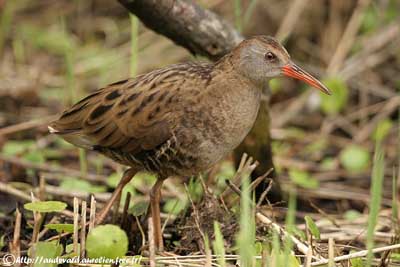
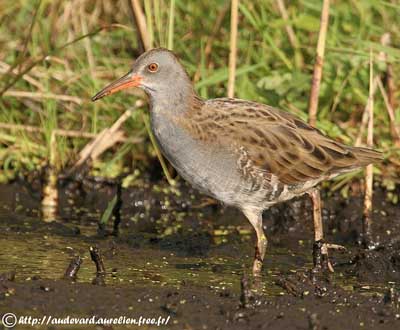
We find four subspecies:
R.A. hibernans; R.a. aquaticus; R.a. korijewi; R.a. indicus.
They share the wide range and slightly differ in colour and pattern of plumage.
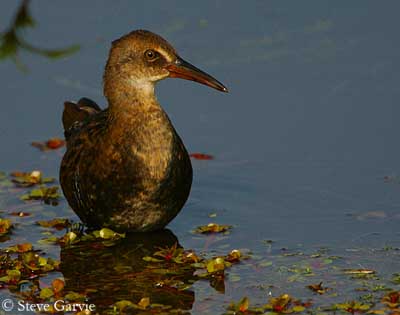
VOICE: SOUNDS BY XENO-CANTO
Water Rail has very peculiar call, a kind of pig-like screams, grunts and squeals given in explosive series “groo-groo-gruuueeit-gruit-groo-gru…”
This call is often uttered at dawn and dusk or when the bird is surprised by something, noise or intruder.
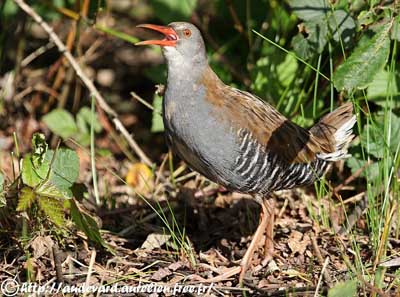
HABITAT:
Water Rail frequents thick reedbeds and marshes, and numerous kinds of wet habitats with aquatic vegetation and slow-moving water.
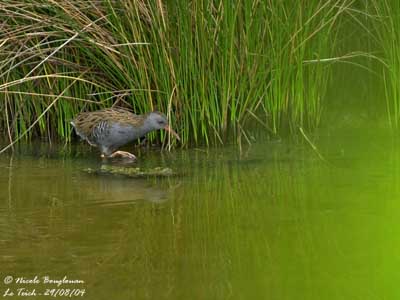
It often forages in muddy soils and it is frequently hidden in small or narrow wet areas within other type of habitat.
This species breeds in reedbeds, swamps with emergent vegetation, marshes and fringes of open water, floating islands, rice fields and ponds. It frequents both fresh and saline water.
During the migration, Water Rail frequents all kinds of wet habitats.
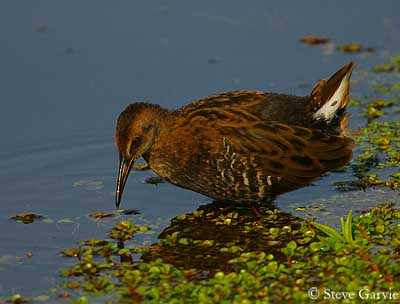
RANGE:
Water Rail is found in most parts of Europe, except Scandinavia and northern parts of Russia.
It is sedentary in Western Europe where the birds coming from central and east Europe join them for wintering. Most of them winter in the Mediterranean Basin.
These birds are able to fly very long distances in migration.
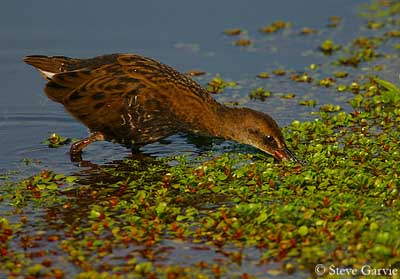
BEHAVIOUR:
Water Rail is omnivorous, feeding on wide variety of invertebrates, plant matter and carrion. It forages on dry shores or mud near water, also in shallow water where it finds preys on or below the surface.
It also catches preys in the emergent vegetation.

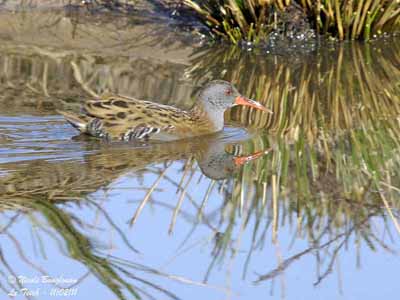
It rarely dives, but may feed while swimming.
This bird is able to climb into bushes to take berries, and to fly into tree for fruit.
Water Rail uses its long bill for probing into the mud or shallow water, searching for invertebrates. It also may eat dead birds found after frozen period.
During the cold days of winter, this shy bird may be seen leaving the frozen reedbeds where it is living to reach unfrozen areas.
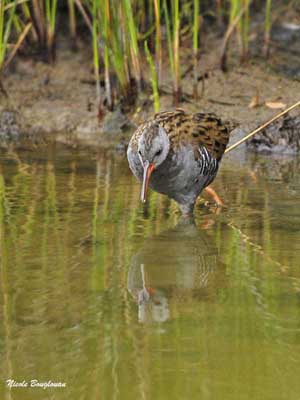
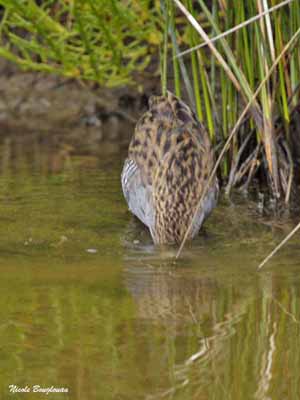
Water Rail moves easily among reeds and marsh vegetation, making it almost invisible for raptors such as Marsh Harrier which is a predator.
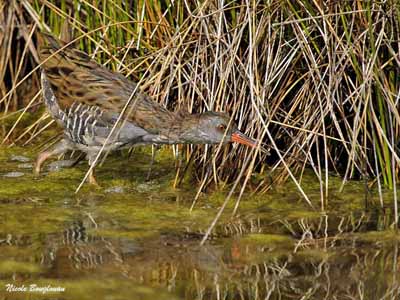
Water Rail is more vocal during the breeding season, and mainly during courtship displays, but intensive calling is also used in establishment of the territory. They communicate with their loud, distinctive advertising calls.
Water Rail male performs some displays involving bowing with head down and raised tail, and sometimes raised wings too. These courtship displays allow the male to expose the beautiful flank patterns and also the chestnut-coloured undertail coverts. Displays are accompanied by calling.
The Water Rail is monogamous and very territorial during the breeding season. It is solitary nester, nesting well hidden in reedbeds.
Water Rail of Western Europe are mainly sedentary, but the birds living in the northern parts of the range migrate southwards and to south western parts for wintering in the Mediterranean Basin, North Africa and eastern to central Caspian area.
They migrate at night, flying in broad fronts, and are able to cross high mountainous regions such as Alps.
FLIGHT:
Water Rail has rounded wings. It performs a laboured fluttering low flight with dangling legs when flushed. This species, such as most of the Rallidae, is able to fly strongly and steadily with the feet projected beyond the tail when well underway.
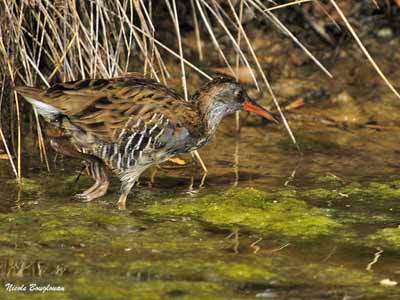
REPRODUCTION:
Breeding season varies according to the range.
Water Rail nests in reedbeds. The nest is a bulky cup made with dead leaves and plants stems. It is often concealed in thick vegetation on the ground near water, or on water, rarely in open area. It may be built up to avoid flooded water. Both mates build the nest.
Female lays 6-11 eggs at daily intervals. Both parents incubate during 19-22 days.
Chicks are precocial and covered with black down and have whitish bill.
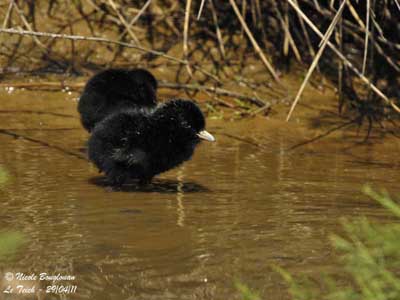
They are fed by their parents during 20 to 30 days, but they are able to feed themselves five days after hatching. They are independent and able to fly 7-8 weeks later. They can breed at one year.
This species produces two broods per year.
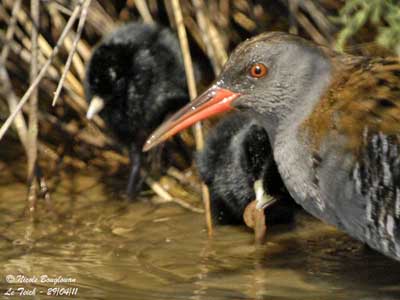
DIET:
Water Rail is omnivorous, feeding on wide variety of terrestrial and aquatic insects and larvae. It also consumes worms, fish, molluscs, crustaceans, spiders and grubs.
It regularly eats amphibians and small rodents, but it also takes carrion and killed small vertebrates, and even small birds.
This species feeds also on plant matter such as roots, seeds, berries and fruits, mainly in autumn and winter.
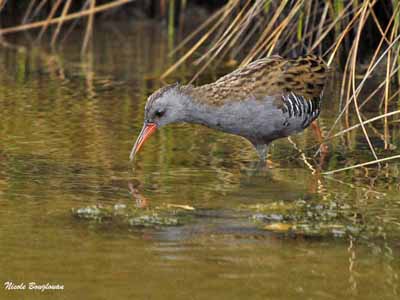
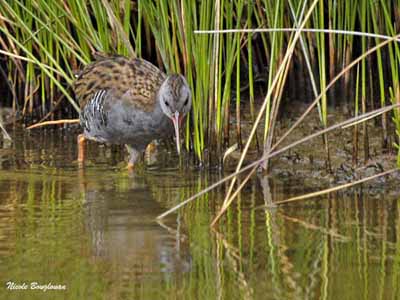
PROTECTION/ THREATS/ STATUS:
Water Rail has stable populations at this moment, and this bird is locally common in most parts of the range.
It is difficult to observe this species which is often hidden among the vegetation, and to give the right numbers.